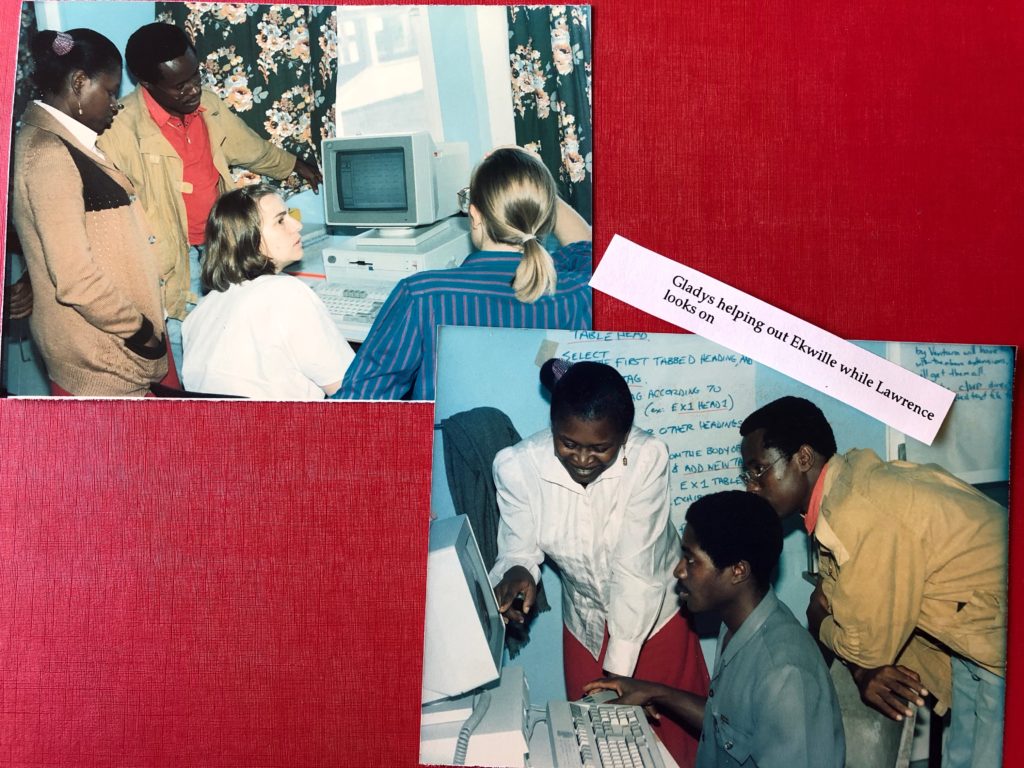Below is a piece published in Ventura Professional magazine (for users of Ventura Publisher software) around September, 1988. I was horrified that the magazine added cartoons of monkeys unloading a boat in a jungle, a giraffe, and a crocodile. I sent copies of the article to my students in Buea because I thought they’d like to see their names and accomplishments mentioned in print, but I apologized to them for the images. The photos above were not included in the article. – at the state of printing technology at the time, line art was a far cheaper option for the magazine.
Interesting aside: My writing style really hasn’t changed in 33 years.
Into Africa
Have Desktop Publishing, will travel? This lady does, and did from, as the movies used to say, darkest Africa to the snows of Kilimanjaro!
by Deirdré Straughan
What did I do on my summer vacation? Well, I spent most of August in Buea, Cameroon (West Africa), installing a desktop publishing system at the Pan African Institute for Development. PAID is one of four regional institutions which develop and conduct a variety of training programs for public and private sector participants from all over Africa. All such institutions generate a lot of paper, particularly in the form of training manuals. The World Bank’s Economic Development Institute saw that desktop publishing could be valuable to PAID and similar institutions, and asked us to install a system at Buea as a pilot project.
My baggage was seven boxes of equipment — all the components of DTP heaven. The configuration included a Tandon PAC 286 (a classy-looking computer with rugged removable hard drives); an HP Series II printer, configured with the LaserMaster LC2 printer controller; a Wyse 700 monitor; an Advanced Visions Research scanner with graphics and OCR software; and Ventura. This was the best system I could assemble for under $15,000, and addressed several needs specific to PAID.
The LC2 printer controller meant a tremendous increase in printing speed (especially important when printing long documents) and included 35 fonts – plenty of variety to keep a fledgling publishing team happy. The AVR scanner with MegaRead optical character reader software allows PAID to scan text from previously developed training materials directly into WordPerfect format, for revision and reuse without retyping. The PAC 286’s removable hard drives meant I could load up the software during pre-trip equipment assembly and testing, then pop out the fully-configured drive and carry it in my briefcase — saving hours of installation time on-site. The only problem was at airport security checkpoints — no one knew what that strange metal object was!
The equipment arrived, miraculously in working order. We were also able to borrow three IBM PS/2s for the training period, which meant one machine for each of the trainees. (I can now tell you the visible performance difference between an IBM PS/2 Model 50 and the Tandon PAC 286… none.)
There were installation problems – only two outlets for all the equipment, and the extension cords and multi-plugs provided were so loose that we kept tripping over and disconnecting them. We learned to save our work frequently.
And it was the monsoon season in Cameroon, with rain eight hours a day, heavy rain. Every sheet of paper went limp instantaneously, and laser printer toner tended to clump and smear. We borrowed a dehumidifier, which had the welcome incidental effect of warming up the place.
The trainees, soon to be a desktop publishing production team, were Cameroonians (Gladys Njoh, Ekwille Manfred Evakise, and Gweh Lawrence Naah) and one Canadian volunteer, Johanne Roy, who is a specialist in computer education and would help keep things on track after my departure. The Cameroonians had never used computers before, so training began with the basics — what a computer is and how it works, and DOS.
We moved on rapidly to word processing (WordPerfect); the team devoured information, ten hours a day at their request. They understood immediately the benefits of this technology for their daily work, and were eager to learn.
In all of our DTP training, Team Technologies tries to work with the publications which the trainees actually need to publish. This gives focus to the training, allows the trainee to be working while training (sort of on-the-job training in reverse), and, most important, gives a clear measure of success for the training/installation.
The publication project to be completed during PAID’s installation was a set of training materials for the Agricultural Management Training for Africa Program, which PAID was to host in September. I myself would have found it difficult to complete these materials in the allotted time, even with a fully Ventura-fluent team of desktop publishers. There were tabbed tables, graphic charts, and hundreds of files to keep track of — all a beginning publisher’s worst nightmares rolled into one time-constrained, must-be-perfect project. So WordPerfect and Ventura training were both very much applied to the tasks at hand.
As the team learned word process-ing, they typed in the materials; as they learned Ventura, they published them. Plenty of hands-on practice for all! In the meantime, I was writing guidebooks and glossaries for my students and developing a Document Production Management System. This was primarily a set of forms (one to track the flow of documents back and forth between us and the writers/editors, one to track the WordPerfect and Ventura files associated with each chapter of the training manuals) and in/out trays to keep things moving. But management also meant frequent meetings to ensure that everyone knew what everyone else was doing, to help the writers work with us, and to work with them on developing the design and layout of the books.
When I left on August 24th, the team was unsure of itself in some areas (especially file management), but overall fairly confident. I had more faith in them than they did in themselves, and wasn’t surprised to hear that they came through with flying colors, producing the most beautiful training manuals PAID had ever seen, and in time for the training.
By all measures, the project was a success. But to me the most important measure was made at the personal level. The PAID team learned a tremendous amount — from zero to desktop publishers in six weeks! and they enjoyed learning it. They immediately used their knowledge to produce valuable, tangible results, and (after a vacation, we hope!) are ready to apply it to further areas of their work. In their own words: “I am fascinated by how good the work I produce can look… It is a world of knowledge I have acquired… I shall do all my best to produce good publications befitting an international institution like ours.” (Gladys Njoh) “I am going to use the technology in a way that will interest others and not only myself. I will always make sure to try using it to solve people’s problems to their satisfaction.” (Gweh Lawrence Naah)
The project was also a success as a pilot, and, as we’d hoped, is leading to similar projects elsewhere. Next month I’m off to Tanzania, to teach Ventura under the snows of Kilimanjaro!
When not off in the wilds of Africa, the multi-talented Deirdré Straughan is Director of Desktop Publishing for Team Technologies, Inc. She can be reached in Herndon, VA at (703) …..





